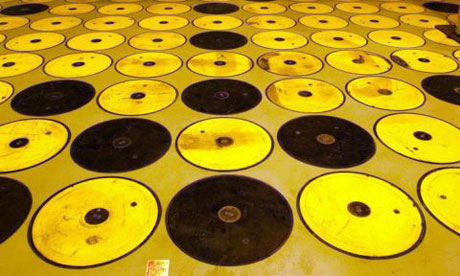 Posted by Duncan Clark
Posted by Duncan ClarkAlmost 700m tonnes of CO2 would be released into the Earth's atmosphere by even the smallest nuclear conflict, according to a US study that compares the environmental costs of developing various power sources

Nuclear waste stored at Sellafield. One of the side-effects of developing nuclear power is the risk of war, the report warns. Photograph: AFP
Just when you might have thought it was ethically sound to unleash a nuclear attack on a nearby city, along comes a pesky scientist and points out that atomic warfare is bad for the climate. According to a new paper in the journal Energy & Environmental Science, even a very limited nuclear exchange, using just a thousandth of the weaponry of a full-scale nuclear war, would cause up to 690m tonnes of CO2 to enter the atmosphere – more than UK's annual total.
The upside (kind of) is that the conflict would also generate as much as 313m tonnes of soot. This would stop a great deal of sunlight reaching the earth, creating a significant regional cooling effect in the short and medium terms – just like when a major volcano erupts. Ultimately, though, the CO2 would win out and crank up global temperatures an extra few notches.
The paper's author, Mark Z Jacobson, a professor of civil and environmental engineering at Stanford University, calculated the emissions of such a conflict by totting up the burn rate and carbon content of the fabric of our cities. "Materials have the following carbon contents: plastics, 38–92%; tyres and other rubbers, 59–91%; synthetic fibres, 63–86%; woody biomass, 41–45%; charcoal, 71%; asphalt, 80%; steel, 0.05–2%. We approximate roughly the carbon content of all combustible material in a city as 40–60%."
But why would a Stanford engineer bother calculating such a thing? Given that the nuclear exchange would also kill up to 17 million people, who's going to be thinking about the impact on global warming?
The purpose of the paper is to compare the total human and environmental costs of a wide range of different power sources, from solar and wind to nuclear and biofuels. One of the side-effects of nuclear power, the report argues, is an increased risk of nuclear war: "Because the production of nuclear weapons material is occurring only in countries that have developed civilian nuclear energy programs, the risk of a limited nuclear exchange between countries or the detonation of a nuclear device by terrorists has increased due to the dissemination of nuclear energy facilities worldwide."
"As such," Jacobson continues, "it is a valid exercise to estimate the potential number of immediate deaths and carbon emissions due to the burning of buildings and infrastructure associated with the proliferation of nuclear energy facilities and the resulting proliferation of nuclear weapons … Although concern at the time of an explosion will be the deaths and not carbon emissions, policy makers today must weigh all the potential future risks of mortality and carbon emissions when comparing energy sources."
I'm not a huge fan of nuclear energy, and I agree that a large roll-out of atomic power must on some level increase the likelihood of nuclear terrorism or war. However, it does strike me as faintly absurd to try and quantify this risk – particularly the way Jacobson does it. Here's how he crunches the numbers:
"If one nuclear exchange as described above occurs over the next 30 years, the net carbon emissions due to nuclear weapons proliferation caused by the expansion of nuclear energy worldwide would be 1.1–4.1g CO2 per kWh, where the energy generation assumed is the annual 2005 generation for nuclear power multiplied by the number of year being considered."
In other words, if nuclear power leads one exchange of fifty 15 kilotonne nuclear devices over 30 years, then that equates to 4.1 grams of extra CO2 for each kilowatt of nuclear energy produced. Why, you might ask, has Jacobson chosen one exchange, 50 nuclear war heads and 30 years? Good question. Those figures, as far as I can tell, are entirely arbitrary, and as such I'm rather surprised that the Royal Society for Chemistry are prepared to publish them in their journal.
Putting those doubts to one side for a moment, it's interesting to note that nuclear looks very bad in the report even if you ignore the warfare component of the carbon footprint. Far more serious (by a factor of 15 to 25) is nuclear's opportunity cost: the emissions savings lost during the decades of planning and building of each nuclear station. Once again, however, there's no explanation about how these figures are calculated, so it's hard to know whether they're valid.
Either way, nuclear doesn't come out as badly as first- or second-generation biofuels. These, the author remarks, are "ranked lowest overall and with respect to climate, air pollution, land use, wildlife damage, and chemical waste," and may actually "worsen climate and air pollution" relative to fossil fuels. Carbon capture and storage also gets a thumbs down. By contrast, wind, solar and marine energy score well on the wide-ranging criteria, which include carbon emissions, land demands and even thermal pollution.
As the first study to compare energy sources in so many different ways, the report is both interesting and welcome. Unfortunately, it's unlikely to make much of an impact – not just because there's no mention of the economics of each energy source, but because the half-baked quantification of nuclear war's climate impact makes the whole study seem somewhat unconvincing.



No comments:
Post a Comment